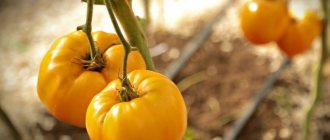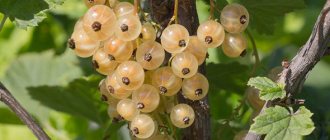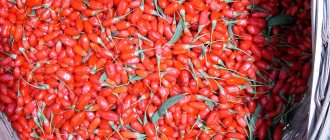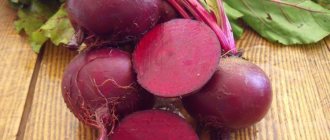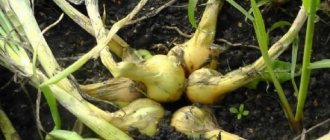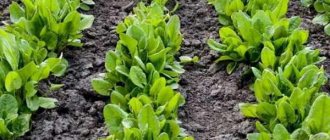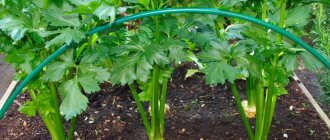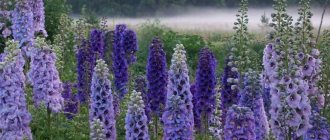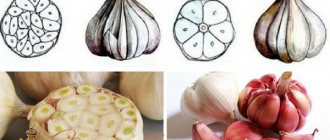Many summer residents eventually get tired of “ordinary” garden crops and want to grow something unusual, but at the same time, useful on their plot. In this case, they need to pay attention to leeks.
Dear readers! For you, we have created communities on social networks in which useful articles and interesting ideas are published several times a day! Subscribe and receive useful content in a convenient format!
This is a variety of ordinary onion with an unusual taste and many beneficial properties.
Leeks can be grown either as seedlings or directly sown in open ground. This culture is easy to care for and does not require any special knowledge.
However, a beginner may have some questions about growing seedlings.
We will talk about them in today's article.
Botanical description of the leek variety
The main distinctive feature of leek (Allium porrum) is the absence of the usual bulb and flat sword-shaped leaves about 0.3 - 0.7 m in height. Outwardly, they look more like garlic, but are not so pointed and more meaty.
The color of the feathers varies in shade - from light to dark green. You can often notice a bluish tint. The false stem is white, approximately 10–30 cm.
In cultivation, leeks live for 2 years. It blooms only in the 2nd year, forming an arrow with a spherical inflorescence. Flowering occurs in the second half of summer.
However, this vegetable is usually grown for only one year, since in the second year the plant loses most of its qualities for which it is valued (medicinal properties and unusual taste).
THIS IS INTERESTING. Another name for this variety is pearl onion.
Problems during cultivation
Leeks - what is it?
When growing leeks, a gardener may encounter some problems, namely:
- The plant may become ill with viral or fungal diseases;
- Rot;
- Damaged by pests.
The most dangerous pests of leeks are onion flies. Therefore, when mulching between rows, ground pepper and mustard are added to the mulch. In addition, the plant can be protected from pests by planting carrots nearby.
If the plant has rust or powdery mildew, then such stems must be removed immediately. In this case, those plants that remain must be treated with copper oxychloride and the drug “Fitosporin”.
Algorithm for sowing seeds step by step
- Step 1. Purchase seeds, seedling containers and soil.
- Step 2. Disinfect the planting containers with a solution of potassium permanganate.
- Step 3: Make drainage holes.
- Step 4. Prepare the seeds for sowing.
- Step 5. Pour soil into planting containers.
- Step 6. Make grooves. Depth – 15 mm, distance between grooves – 50 mm.
- Step 7. Place the seeds in the grooves at a distance of 50 mm from each other.
- Step 8. Gently sprinkle with soil.
- Step 9. Use a syringe or spray from a spray bottle.
- Step 10. Place the container with beans in a plastic bag or wrap it with film.
- Step 11: Place in a warm and dark place.
- Step 12. Periodically ventilate and moisten the soil.
Sowing leeks for seedlings
Getting leeks from seeds is quite simple. 2 months before the intended planting of plants in the ground, prepare convenient containers and fertile soil. Wooden boxes, plastic or peat cups, and cassettes are suitable for forcing leek seedlings. They must be deep to accommodate the powerful root system of plants and have drainage holes at the bottom to drain excess liquid.
To grow leeks through seedlings, use light, loose, moisture-intensive soil mixtures that are rich in humus and other nutrients. You can prepare them yourself or buy ready-made soil mixture for vegetables in stores. Leek seedlings also grow well in special peat mixtures.
To plant seeds, containers are filled with soil and moistened well. In boxes, plants are placed at intervals of 5 cm. In cups and cassettes - one in each container or cell. Seeds, germinated or dry, are buried 1 cm into the ground. You can simply lay them out on the ground and sprinkle a layer of earth on top. Next, the containers are covered with film to retain moisture and left indoors at a temperature of 22-25 °C.
How to determine sowing time?
Sowing seeds
Depending on the region, the timing of sowing leek seeds for seedlings varies significantly. The second factor that determines planting time is the variety. Late-ripening ones should be planted earlier, as their growing season lasts longer.
The average growing season for this vegetable is approximately 200 days from the time of sowing. Thus, it is easy to calculate the approximate time for planting seed material:
- If you replant onions in mid-June, then sowing the seeds must be done in April.
- To replant during the May holidays, planting must be done on the 20th of March.
- To get a later harvest, planting material begins to be prepared in late February - early March.
Care
Onion quality and yield are affected by seed material and growing technology. Leeks do not require special care. Basic agricultural practices:
- Weeding . The main agrotechnical technique for growing is systematic weeding and weed removal. It is difficult to use chemical methods for removing weeds when cultivating onions.
- Watering. Proper watering is essential for proper leek development. It is important that the substrate is moderately moist; onions are extremely sensitive to drought, especially during seed germination. Systematic irrigation should also be carried out during the growth period; depending on the variety, the period of increased moisture varies. On average, the need is 25-30 mm of water per 1 irrigation (250-300 liters per hundred square meters).
- Loosening the soil . Simultaneously with weeding, the soil is loosened in the inter-row spaces to a shallow depth of up to 3 cm; more intensive tillage can damage the roots.
- Thinning . If sowing was carried out directly into the ground, it is necessary to thin out when the first 2 true leaves are formed or when the plants reach a height of 10 cm. Weak plants are pulled out, leaving stronger ones at a distance of 15 cm. Thinning is best done after rain or after watering, when the soil is sufficiently moist .
- Hilling up . This technique allows you to get a longer white part. The soil is buried under the stem to the base of the leaves.
Bad days
The lunar calendar says that leek seeds should not be planted on new and full moon days.
In 2021, these lunar phases fell on the following dates:
In January – 13, 28.
In February – 11, 27.
In March – 13, 28.
In April – 12, 27.
In May – 11, 26.
Is it possible to plant leeks on a waxing moon?
What’s convenient about growing leeks is that you can sow them not only on the waning moon, like other root crops, but also on the waxing one. In this case, summer residents are guided by the rule that any seeds must be sown precisely on the waxing moon.
Thus, in the lunar calendar, only the days of the new moon and full moon remain unlucky.
In any case, no matter what lunar phase you choose, follow the rules of agricultural technology. This is the most important thing when sowing onion seeds.
Harvest and storage
Leeks should be harvested in stages. The first stage occurs in the first half of September. It is worth removing not all plants, but selective ones, in order to provide more space for the rest of the plantings. Final cleaning can also be done during frosts - an adult plant is not afraid of them.
If you plan to store the crop for a long time, then you need to dig up the onions carefully to prevent damage. After digging, you need to remove the soil and partially trim the roots - the bottom of the bulb cannot be touched.
You can store the harvest in different ways. If you want to preserve fresh plants, then the options are as follows:
- Fridge . Only strong specimens are suitable for this storage method. They need to be cleaned, roots trimmed and cooled at zero temperature. Then immediately place the leeks in perforated plastic bags and put them in the refrigerator. The culture is stored in this way for up to 5 months.
- River sand . In this case, the crop must be removed for storage immediately after harvesting. The bottom of the box should be covered with sand in a layer of at least 5 cm. Place the leek vertically, sprinkled with wet sand - the layer should be 15 cm. At zero temperature, the crop can be stored in sand for up to six months.
When storing fresh crops, you need to periodically inspect them to get rid of spoiled specimens. Without such measures, shelf life is significantly reduced and losses increase.
There are other options for storing leeks - drying and freezing. In both cases, the plants must be thoroughly washed, dried on a wire rack and cut into thin slices. Dried onions should be placed in closed jars. For freezing, prepared raw materials must be placed in tight bags or containers; there is no need to defrost them for cooking.
How to plant and grow leeks, harvest and store the harvest is described in this video:
Leeks can be grown in any region if you choose the right planting method. The quality and quantity of the harvest depends on compliance with the rules of crop care - all of them are quite simple and standard.
0
0
Copy link
When to plant depending on the region?
Climate is critical in determining when to plant seedlings. This happens for the following reason.
Leek seedlings can be transplanted at the age of 50 - 60 days. Accordingly, by this moment the weather should already be good outside the window. Please note that planting should not be done on the first sunny and warm day, but when the threat of morning frosts has passed, the soil has warmed up and the sun will sufficiently warm the air throughout the day.
- In the Caucasus, Crimean Peninsula, Rostov Region and Krasnodar Territory, seeds are sown already in the last ten days of February.
- In the Central Black Earth region, sowing is carried out in the first days of spring.
- In the Middle Zone, the capital region and the Volga region, the planting date is May 10–20.
- In the Leningrad, Pskov and Novgorod provinces , in the Republic of Karelia leeks can be sown in late March - early April.
- In the Urals, Far East and Siberia, seedlings begin to be cultivated late, in early April.
ON A NOTE. If seedlings are transplanted into a greenhouse, then preparing planting material can begin 7 to 10 days earlier.
Leek diseases and their control
Of the diseases, the most dangerous is mosaic - the aphid carrier of this viral disease. Longitudinal yellow spots appear on leek leaves.
Leeks also suffer from such fungal diseases
: rust and powdery mildew.
For powdery mildew
Oval spots appear, increasing in size over time, on the leaves of leeks.
Plants affected by these diseases become inedible.
Rust
manifests itself by the presence of bright yellow spores on leek leaves. Affected leaves dry out.
How to fight diseases?
It is necessary to treat the plants and soil in the area with a solution of copper oxychloride or Fitosporin.
Viral diseases are not curable, so agrotechnical techniques will help cope with the mosaic:
Weed and pest control; Maintain crop rotation; Seeds for sowing must be disinfected; Removal of infected plants; Growing leek varieties resistant to viruses.
How to care for leek seedlings, any tricks?
After the first shoots appear, the seedlings need to be provided with appropriate care, which includes appropriate maintenance conditions and proper care.
The onion seeds have sprouted, what to do next?
Onion seedlings
First of all, the onion should be provided with the necessary conditions:
- Light . Onions need UV rays 12 hours a day. Use phytolamps.
- Temperature . Should be slightly below room temperature. During the day – 18 degrees, at night – 14 degrees.
- Watering . Regularly as the soil dries out. The water should be warm and settled.
- Humidity . Above average. If the climate is too dry, spray.
How to feed onion seedlings?
Unlike other seedlings, leeks prefer organic fertilizers. The most effective is bird droppings, which are diluted in water in a ratio of 1:20.
The first feeding is carried out 15 days after the first shoots hatch. Subsequent feeding schedule: 2 times in 30 days. The last time fertilizer is applied is a week before transplanting. By the way, this is exactly when the hardening procedure begins.
How to pick onion seedlings?
Picking will have to be done if you planted the seedlings in a common box. Picking is necessary to thin out the plantings, otherwise the plants will not have room to grow.
You need to carefully pry the leeks using a popsicle stick or similar tool. First you need to moisten the soil with water. Then the desired seedling is carefully lifted with a stick and removed along with a lump of earth. Then it is transferred to a new container.
ON A NOTE. After picking, you can add fertilizer or a growth stimulant to help the plants take root in the new location.
Do I need to harden off onion seedlings?
Hardening is an important procedure that allows onions to survive transplantation into open ground. It is carried out 1 - 2 weeks before planting in a permanent place.
First of all, you should reduce watering. Then place the boxes with seedlings outside and gradually increase the period of time the seedlings stay in the open air.
Fertilizer
Leeks are medium-deep-rooted plants and have high nutritional requirements.
Organic fertilizer is most desirable for growing this onion, so it should be grown in the first or second year after applying manure and compost. The recommended dose is 30-40 tons per hectare (300-400 kg per hundred square meters).
Organic fertilizer, especially organic matter that is not fully composted, should not be applied more than a year before planting. It is better to plant leeks on the site as a second vegetable after adding organic matter. Onion vegetables grow well after early harvested cucumbers or potatoes.
The more time passes from using manure, the more in subsequent years it will be necessary to supplement this type of fertilizer with mineral compounds.
Mineral fertilizer is applied to the soil (use preparations with basic nutrients - NPK 3 weeks before planting). If necessary, foliar fertilizing is also used, usually with nitrogen fertilizers, no later than 6 weeks before harvest. Heavy rains require a 30% increase in doses.
Approximate doses of mineral fertilizers (active ingredient kg / per hundred square meters):
- nitrogen – 1-1.5;
- phosphorus – 0.6-1;
- potassium – 1-1.5.
Phosphorus and potassium fertilizers, as well as half the dose of nitrogen, are applied 2 weeks before planting the seedlings, the rest of the nitrogen is applied later.
Doses of phosphate fertilizers are determined based on chemical analysis. The optimal phosphorus content in the soil should be at least 60-80 mg/dm³. In the absence of fertilizer recommendations, the approximate dose is 1-1.5 kg/acre in the form of double superphosphate.
The potassium content in the soil should be at least 150 mg/dm³ on light soils and 300 mg/dm³ on medium soils. In the spring, potassium sulfate is added at a dose of 1-2 kg/acre.
When planting leeks, nitrogen fertilizers are usually applied twice:
- before sowing (planting seedlings);
- in the plant growth phase - usually 2 months after the first dose.
Foliar feeding is especially valuable in the 4-6 leaf phase.
Is it possible to immediately sow seeds in open ground?
Leek is one of the crops that can be grown without seedlings. But you need to be aware that in this case the yield will be noticeably lower than when grown by seedlings.
Sowing in open ground is carried out in the first ten days of April, but only if there are no morning frosts. That is, this method is not suitable for the Urals, Siberia and the Leningrad region. You need to sow late-ripening varieties that will ripen in the fall.
REFERENCE. Also, this type of onion can be planted before winter, just like garlic.
Cultivation care
Growing leeks in Siberia and caring for them
Leek care includes the following processes:
- loosening the soil;
- hilling;
- weed control;
- watering;
- feeding
In order to make your work easier, it is best to mulch. This will not only save the gardener from unnecessary work, but will also allow the plant to feel more comfortable and contribute to its growth and development.
If the onion stem becomes the diameter of a pencil, then you need to add a little soil to the hole. After this, you need to hill up the plants every fourteen days. This way the white leg will be longer. During the entire crop growing season, at least four hillings should be carried out. This procedure is recommended to be done during watering.
It is necessary to water leeks as this plant requires moisture. During the first half of intensive plant growth, it is necessary to water and fertilize the soil regularly. The best fertilizers would be bird droppings diluted in water at a ratio of one to twenty, and mullein in a ratio of one to eight with water.
Watering the onions is required
The stalk of an onion is eaten; if this crop is properly cared for, it will grow no less than half a meter. The thickness of the stem will be from three to four centimeters.
Leeks are not afraid of frost. It can easily withstand temperatures down to -7 degrees below zero. Moreover, in areas with a mild climate it can winter, covered with snow. But if the summer is still cold and rainy, then the stem remains thin and long.
At the same time, resistance to cold also depends on the type of leek. The only thing that saddens me is that winter plants do not have time to ripen. Therefore, they are best grown in greenhouses. If the leek was grown in open ground, it is then transplanted into a box and brought to a warm place. This process must be completed before the first frost.
Important! Leeks do not stop growing even in the most unusual conditions. If you move it to the basement, it will continue to develop, but for this you need to continue to properly care for the plant and do not forget about feeding.
When to plant seedlings in open ground?
Planting in open ground
It is believed that leek seedlings are most ready for transplanting to a permanent place 50 - 60 days after germination. Depending on the region and variety, planting is carried out in May or June.
- For the coldest regions of our country, transplantation is best done in the tenth day of June.
- For warmer regions (Black Earth Region, Kuban, Crimea and Caucasus) - in early May.
- For Moscow, the Volga region and the Middle Zone - in mid-May - early June.
Brief characteristics of the plant
Leek (Allium ampeloprasum) is a biennial plant belonging to the amaryllidaceae family. In the first year it forms a root system, a shortened stem and long leaves. In the next growing season, the plant produces flowers and seeds. In gardens, as a rule, it is grown as an annual. This bow came to Europe from Asia Minor in the Middle Ages. Leeks can be grown in all vegetable growing regions, in the Moscow region, Leningrad region, Siberia, and the Urals.
The plant is distinguished by a shortened stem and long green leaves. It is these two parts that are considered edible. The vegetable has a rather pungent, characteristic taste.
Beneficial features:
- has an antiseptic, that is, disinfectant and antibacterial effect;
- supports digestion;
- reduces blood sugar levels;
- due to easily digestible iron, it can be used in the treatment of anemia;
- affects the respiratory system, increases secretion (leek syrup);
- treats bad breath;
- Leek is considered an aphrodisiac and is beneficial for men.
Unfortunately, the vegetable can cause bloating; it is not recommended for people with peptic ulcers, stomach diseases, or pregnant women.
Leek has high nutritional value and contains:
- a lot of iron;
- folic acid;
- niacin;
- riboflavin;
- vitamins – B, A, C, E, K.
Leeks are fairly easy to grow. The growing season can last 70-170 days depending on the variety.
How to get nigella from leeks?
Despite the fact that leeks are a 2-year-old plant, they are usually used in the first year of cultivation. Some plants are left to overwinter in order to collect seed material next year.
Therefore, to get nigella, the plant needs to overwinter.
To do this, leave a few plants in the garden bed. There is no need for a transplant. In the fall, cut off all the leaves. When the time comes for the first night frosts, cover the plants with dry grass, spunbond, or simply sprinkle with soil.
Next year the bow will shoot. There is no need to cut it. Wait until it blooms (this will happen in the second half of July - August). To avoid losing the seeds, pull a fabric bag over the inflorescence. You can use a stocking or sock the old fashioned way.
Once the onions are ripe, collect the seeds. In winter, sow them for seedlings.
How to plant leeks before winter
Leeks are often planted with seeds before winter, directly into the ground. In the summer, the site is prepared, fertilized and dug up. In November, furrows are made 20 cm apart and seeds are placed 8-10 cm apart in the furrows. Keep an eye on the weather, if it is warm the leeks will sprout and be killed by frost in the winter.
Be sure to mulch the area with peat and snow when it falls. The more snow there is on the site, the better it is for the leek; in the spring it will not freeze until the snow melts and the frosts will pass.
Interesting Facts
Leeks have some medicinal properties. It is rich in potassium, sodium, magnesium, vitamins B and C, and also contains healthy sugars and proteins.
Pastes, gels and solutions based on leeks are used in medicine to produce nourishing and healing masks for hair and nails.
This vegetable is an important part of Mediterranean cuisine. It is used to prepare soups, salads and sauces, and is also consumed raw.
Leeks do not have a bulb in the usual sense. But the stem is more pronounced. By the way, this is the most delicious part of the vegetable.
Leeks have been known to mankind for more than 4000 years. The first mentions of it date back to the era of Ancient Egypt and Mesopotamia.
This vegetable is the symbol of Wales.
The benefits and harms of leeks
Leeks are a very healthy vegetable product that should be included in the diet of any person. The plant has absorbed almost 85% of water, and also contains a small amount of carbohydrates, protein, sugar, starch, and organic acids. Leeks boast a high concentration of such groups of vitamins as “B” and “C”, carotene, and minerals. The product is rich in potassium, magnesium, iron, phosphorus, calcium.
It has a beneficial effect on the body by supplying essential vitamins and minerals. Being a weak diuretic, it removes excess fluid from the body. Improves the functioning of the gallbladder, helps improve metabolism, stabilizes liver activity, and effectively fights genitourinary diseases. Leeks have an antioxidant and antihypoxic effect on the body as a whole.
The healing properties of leeks were mentioned in the 70s; it was recommended to use it for uncomplicated gout, scurvy, rheumatism, ARVI and physical fatigue. Leeks improve appetite and are indicated for disorders of the gastrointestinal tract.
Undoubtedly, leeks are useful, but people with individual intolerance to the product should avoid it altogether, and those prone to allergic reactions should consume leeks in small portions.
Answers to frequently asked questions
For beginners, growing seedlings often seems difficult. They often have questions about one thing or another. There is no need to be ashamed of this. Almost every summer resident had similar problems at the beginning of his activity.
What soil should I buy for growing seedlings?
To grow seedlings, the soil should be light, with a neutral pH level. You can prepare the soil yourself, but it is best to buy ready-made substrate in the store. A universal mixture or soil, which is marketed as for seedlings, is suitable.
You should not overpay money for any special specialized substrates. With a high degree of probability there will be the same soil mixture.
How can you stimulate seeds for further growth?
An experienced summer resident who has grown more than one seedling knows exactly what preparations need to be used. We advise beginners to use the most common products: Gumi, Zircon, Humate, Agricola, Epin, Energen, etc.
IMPORTANT! Follow the instructions on the package exactly and do not exceed the dosage, otherwise you may “burn” the plants. When feeding for the first time, it is recommended to completely reduce the concentration of the active substance by 2 times.
Why don't the seeds germinate?
A very common mistake is deep sowing of seeds. As a result, after 2 weeks, when the shoots should already appear, the summer resident is puzzled as to why the seeds did not sprout.
The second popular reason for this problem is the use of old planting material. If you don’t want to waste time, effort and money, use “young” seeds. Remember that a stingy person always pays twice.
The third reason that the seeds did not germinate is the lack of stratification. The seeds “sleep” and will wake up closer to warm days.
When will the seeds sprout?
If planted correctly, you will see the first shoots within a couple of weeks after sowing. The bulk of the sprouts will appear by day 20.
Why are seeds soaked?
Each seed has a dense “shell”. To germinate, the seed needs to break through this shell. Soaking softens the “shell”. In addition, after soaking, you can see which seeds are dummies.
How to harden seedlings?
An important trick that not all novice gardeners know about is hardening off seedlings. It's very easy to do.
When there are several weeks left before the expected date of transplanting the seedlings into open ground, take the boxes with seedlings out onto the balcony. First for 2 hours, then for 6, then for half a day and, finally, for the whole day. The seedlings will get used to the new conditions for themselves and by the time of planting they will already be hardened enough to endure it painlessly.
What to do if leek seedlings do not grow?
Use growth stimulants (Epin, Zircon) and move the boxes closer to sunlight.
Culture propagation
Leeks are propagated only by seeds, but in most cases they are grown only by seedlings. In order to grow seedlings, seeds must be sown starting at the end of February and throughout March.
Growing seedlings
The container where the seedlings will grow needs to be filled with a nutrient mixture and watered thoroughly. After this, it is recommended to sow the seeds, making small rows, at a distance of 4 centimeters from each other. The row depth should be no more than one centimeter. The surface where the seeds are sown should be covered with a small layer of the mixture and lightly compacted. After this, the crops need to be watered and covered with film or glass. The container with seeds is placed in a warm place, where germination should be expected. In this case, the glass must be opened periodically in order to ventilate the seedlings.
Sowing seeds for seedlings
At the beginning, the air temperature where the container is located should be from 20 to 25 degrees. After the first shoots appear, it is lowered to 12 degrees. This way, the seedlings will grow evenly and will not stretch out.
Thirty days after the leek sprouts, it needs to be plucked. Picking involves replanting the plants into separate cups or thinning them. In this case, leave a distance of at least two centimeters between the stems. Young seedlings are transplanted into a pot with a diameter of 4 centimeters. But it is best to use a peat humus pot or peat tablet. In this case, replanting into individual pots will not be necessary.
While growing seedlings, they need to be fed with compost tea every two weeks. Also, to promote the development of the root system and thickening of the stem, the leaves need to be trimmed regularly, leaving only eight centimeters.
Onion seedlings
When the seedlings grow to the appearance of three or even four true leaves, the diameter of the stem reaches eight millimeters, it is ready for planting in open soil. Before planting, it must be watered abundantly and the leaves must be cut to one third of their length.
But before planting, it needs to be hardened. To do this, the container with seedlings is taken outside. Thus, she is given the opportunity to get used to fresh air and the appropriate temperature.
Sowing seeds
Leeks are grown by seed method in the south of Russia. They begin to sow no earlier than the second half of May. But the beds for sowing need to be prepared in the fall. To do this, they are fertilized with a mixture of fertilizers and covered with black film so that the soil warms up much earlier in the spring.
Sowing seeds in open ground
Before sowing leeks, you need to remember that the seeds are stored for three years. Therefore, it is important to monitor expiration dates. Seeds need to be prepared before sowing. First of all, they are treated with disinfecting mixtures and hardened. To do this, they must first be placed in hot water, the temperature of which is from forty to forty-five degrees. After that - immediately into the cold.
In order for the seeds to germinate quickly, they need to be germinated. This is done this way:
- A cloth napkin is moistened in warm water;
- Seeds are poured onto it and spread into a thin layer;
- Place a wet rag with seeds in a warm place and leave for several days;
- At the next stage, the seeds need to be dried to a free-flowing state;
- Sow into the soil.
Sowing is done in such a way that the row spacing is 12-15 centimeters wide, and there is a distance of at least 15-20 centimeters between the onions themselves. After this, the surface of the bed is watered and covered with a transparent film, or a dome is made.
Watering
But this sowing method applies only to those seeds that were grown at home. If they are bought, then such procedures are not worth doing. There is also no need to soak and germinate seeds that are sown for the winter. The most important thing is to know when to plant leeks in open ground.
Planting seedlings
Planting and care are important for getting a good harvest from leeks. Every agricultural technician knows how to properly plant a plant in open ground. Seedlings should be planted in loamy soil that has a neutral reaction to acidity. It is necessary to prepare the area for planting in the fall. To do this, compost is added, and organic fertilizers should be added in the spring. There is no need to dig up the area.
It is best to choose an area where crops such as:
- potato;
- tomatoes;
- cucumbers;
- beans or other legumes;
- cabbage.
The best time to plant leek seedlings is May. But before planting it needs to be prepared again. First of all, the leaves are cut to a third of their length, then the roots of the plant need to be dipped in a solution of clay and cow dung. The ratio of these substances should be equal. This procedure will help the plant quickly take root in its new location.
Planting in prepared holes
Compost or manure is placed in the prepared seedling holes, after which the seedlings are planted. The roots must be sprinkled with soil, but in such a way that the hole is only half filled. The bed is watered abundantly.
The vegetable planting scheme should be as follows:
- In two-row planting, seedlings are planted at a distance of 15-20 centimeters from each other, with row spacing of thirty centimeters or more;
- With a multi-row planting method, onions are planted at a distance of ten centimeters from each other, and the width of the area between the rows should be no more than twenty centimeters.
Onions grow well in narrow beds, like many other vegetables. Wide row spacing is suitable for growing carrots. At the same time, there are vegetables with which leeks go well together. This:
- carrot;
- strawberry;
- celery;
- beet;
- onion.
Suitable varieties
Modern breeding is aimed at creating new varieties with earlier ripening dates specifically for regions with short summers. The only negative for early ripening varieties is that they are poorly stored. They are used for food immediately after harvesting, or canned, and the surplus is sold.
Mid-season and late onion varieties are grown in central Russia only through seedlings. These plants have a powerful leg with large leaves and are perfectly stored for up to 2.5-3 months.
Early
Shelton F1
The new variety, when planted at the end of April, is ready for harvesting in 12-14 weeks! (in July). Can be grown by winter sowing in the ground. Valued for its high yield (50-80 t/ha) and for its easily cleaned stems when digging.
Kilima
Ripens in 135 days. Forms large false stems bearing dark green leaves, reaching a height of up to 1 meter. Quickly forms a white leg up to 20 cm long. Resistant to fungal diseases, cold-resistant, demanding of soil moisture and nutrition.
Columbus
The Dutch variety Columbus ripens in 85 days! The plant forms a false stem up to 80 cm long. The thickness of the stem reaches 30 cm. Advantages of the variety: disease resistance and persistent white color of the stem (the onion does not need to be hilled to get a white color).
Goliath
Ready for harvesting in 130 days. The bulb is weakly expressed, the length of the white part of the false stem is 28-30 cm. The leaves are raised, gray-green in color. The bulb and leaves are of high taste, sweetish. Valued for its high yield and large size. When harvested, the weight of one plant is 170-200 g.
Vesta
The best variety of domestic selection, specially bred for the Moscow region and central Russia. It ripens in 120 days. The plant is powerful, up to 1.5 m high with light green leaves. It is grown in the north-west of Russia only through seedlings. With repeated hilling, a food stalk 30 cm long is obtained. Valued for its sweet taste and high resistance to the main diseases of the onion family.
Mid-late
Karantansky
The ripening period of the Karantan variety is 130-180 days. The leaves are dark green. The weight of one plant is from 200-300 g. All parts of the plant have a strong, pleasant onion aroma.
Bluewing
Domestic variety obtained at the experimental station in Simferopol. The period from germination to harvesting is 190-200 days. The leaves are green with a pronounced waxy coating. The bleached part of the stem at the bottom is thick. The bulb is weakly expressed. Onions are resistant to downy mildew and quite winter-hardy. Approved for cultivation throughout the Russian Federation.
Tango
Has a pungent taste. The leaves are dark green, 70 cm long. The length of the white stem with the bulb is 15 cm. Resistant to frost and fungal diseases of onion plants.
Lancelot
Ripens in 95-100 days. This is a long-established variety of leek, with grey-green leaves. Resistant to frost.
Late ripening
Akreok
Developed by breeders for the northern regions (Siberia). The leaves are dark with a blue tint and reach a length of up to 0.5 m.
The taste is moderately spicy. Valued for its frost resistance, long-term storage ability and large mass of false bulbs (up to 300 g).
Bandit
A tall plant with blue-green leaves grows in 120-130 days. The white part of the stem is short, only 7 cm. With the help of repeated hilling, this figure can be increased.
Premier
Ripening period is 150 days. Medium height plants with densely packed blue-green leaves with a strong flavor. It has high productivity (5 kg/m2).
The best varieties for the Leningrad region are early ripening varieties with high resistance to temperature changes and return frosts:
- Columbus.
- Vesta.
- Akreok.
Many early varieties are suitable for the Moscow region. Of the mid-season and late ripening periods, it is worth highlighting:
- "Lancelot" and "Bandit" can even winter under light cover.
- Premier.
